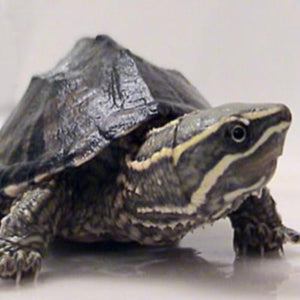The Musk Turtle is a small turtle that is native to eastern United States and southeastern parts of Canada. Musk turtles are a fully aquatic turtle species that inhabit boggy or marshy wetland habitats with clear, shallow slow-moving waters. They thrive in environments near freshwater sources, including ponds and lakes and are frequently found in mud and reeds near these areas and are seen swimming in waters or sunning on logs.

They also like areas with high humidity. These small aquatic turtles are very active, are black, brown or grey in colour and have a long neck, but rather short legs. They have yellow lines on the neck, which can often be seen from above when they are swimming. A species requiring generally similar husbandry in captivity is River Cooter turtles.
Adult Male Size: 4 to 5 inches carapace (10 to 12.5 cm) Adult Female Size: 3 to 4 inches carapace (7.5 to 10 cm) Males can be identified by their longer tails that are topped with spiked protrusions, whereas females have much shorter tails without a spike. If they feel stressed or threatened they may release a foul musky odour from scent glands near their tails. Life expectancy up to 50 years under ideal conditions
Housing
Your musk turtle should have a enclosure with a basking area, opportunities to climb and the ability to swim and dive. Your turtle should have two platforms/ramps – one to be able to bask under a light and another in a cooler area. A depth gradient is a good idea, to allow your turtle to dive if wanted, but also be able to stay in shallower water. The depth of the water depends on the size of your turtle, as they should be able to dive down approximately 4 x their carapace length. The tops of any platforms should be fully out of the water to make sure your turtle has the opportunity to dry out completely to prevent shell rot. Your turtle’s water also needs to be treated with tap/aqua safe, heated and filtered.

The minimum tank size for an adult should be 90x30cm, but the bigger the tank you can provide, the better your turtles will do. For juvenile turtles the minimum should be 60x30cm for up to two turtles and increasing in size for larger groups.
Temperature
All reptiles are cold blooded and need an external heat source to maintain their body temperature. For aquatic turtles you will need to monitor the water temperature, the basking surface temperature and the humidity. Juvenile water temperature: 23-26ºC Adult water temperature: 20-23ºC Humidity: 30-40% Basking surface temperature: 29-32ºC
Wire mesh guards should be fitted over all hot heat sources used in order to prevent thermal burns. The heat comes from the basking spot light and the heater in the water. Your pet shop will advise on heating products and their use suitable for your turtle.

Lighting
Turtles are nocturnal and require UVB lighting to fully absorb and utilise the calcium in their diet. A basking spot light and UV tube/light should be used over the basking area of the turtle. The wattage/strength of these depends on the size of the turtles, how many are in the same tank and on temperatures currently being achieved. This light should be left on all day and turned off on a night to allow the turtle to achieve an appropriate day & night cycle, as they would in nature. The bulbs will need replacing from time to time and your pet shop will advise you.
Furnishings
The floor of the cage should be covered with a suitable substrate such as sand. If using a product like Calci-sand it is recommended that a rich source of calcium is supplied so that the animals do not ingest too much of the substrate as a calcium source (resulting in possible gut impaction). Provide enrichment for the turtles to swim around and climb on, such as rocks, plants or bark. Always make sure your turtles cannot get stuck between any of your décor and they can get in and out of the water easily. It is important for Musk turtles to bask to keep their shell in good condition, so you will need to also give your turtles two platforms (one on either side of the tank); one of these platforms will be for basking under your lights and the other is to allow your turtle to get out of the water in a cooler environment.

Cleaning
Remove droppings and uneaten food daily. Check filter is running correctly and not clogged. Test PH of water weekly and using the water testing guidelines act accordingly – testing your water can indicate when you need to do a water change, etc. Apart from if your testing indicates a water change, this should only need to be done every fortnight if you have a powerful enough filter. A full tank clean should be done every 1-3 months.
Hibernation/Brumation - This mainly occurs in the wild if and when temperatures drop low enough, however they don’t need to in captivity if their conditions remain stable and comfortable. You can induce hibernation by carefully controlling temperatures if you want them to do so though, although this is a complicated procedure and you should ideally seek professional advice before you hibernate your turtle. Before you consider hibernating your turtle, it should be of sufficient size and weight and be showing no signs of illness to cope with the stress of hibernation.
Feeding Musk turtles are carnivorous and will eat a variety of different things including brine shrimp, bloodworm, crickets or turtle pellets. It is important to give your turtle a complete and balanced diet, which you pet shop will advise on. Dust food with calcium+D3 powder (such as Komodo Nutrical) twice a week. The UVB lighting and supplements work in hand to keep your turtles shell and bones strong

General care
A healthy musk turtle should be bright and alert and its carapace should be smooth and the plastron (bottom shell) should be free of any cracks or deformities.
There should be no signs of the following:
- Soft shell disorders: can be due to a lack of calcium and/or vitamin D3 and/or incorrect lighting.
- Shell Rot: check your turtle for a smooth plastron and make sure there are no cracks. A pink tinge to the plastron can also indicate shell rot or an infection. Shell rot can be caused by algae, injury to the shell, excess humidity or the shell never being able to fully dry out when basking.
- Deficiences: such as lacking in Vitamin A or Calcium
- Diarrhoea: this can be caused by incorrect feeding or internal parasite infestation.
- Respiratory problems: signs include fluid or mucus from the nose.
- Mouth rot: cheesy deposits appear in the mouth.
Be careful removing your turtle too much from its habitat, as this can cause problems with their immunity and before moving them make sure you have washed your hands in tap/aqua safe water. Turtles can carry Salmonella, which is most usually contracted by ingestion. Good hygiene practices after handling or cleaning your turtle should be sufficient to prevent any risk of infection.
If you are at all worried about the health of your turtle you should consult your vet or a specialist reptile vet as soon as possible.

Shopping List
Enclosure
Substrate/sand
Basking spot light
UVB tube/UVB heat lamp
Water thermometer
Hygrometer
Basking Surface temp. tester
Tap/Aqua Safe
Platforms x 2
Heater
Light stand/Mounting bracket
Food
Filter
Calcium/D3 powder
Décor
Turtle safe cleaning supplies
Water testing kit
Remember you must never release your pet into the wild.

